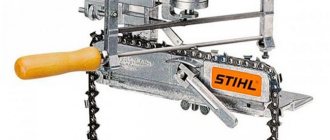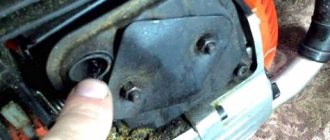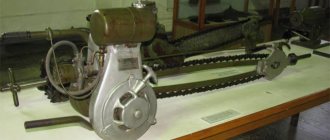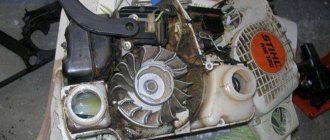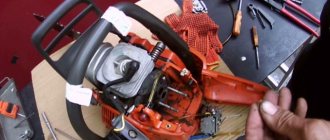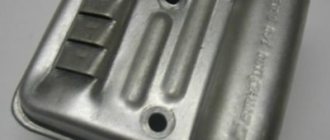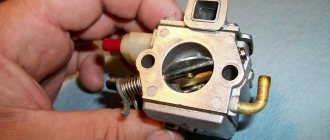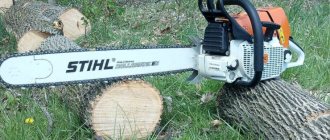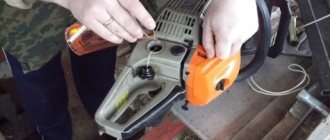Related Posts
What to do if your chain saw won't start
Good afternoon, dear readers and subscribers of my blog! At some inopportune moment, you may find that your chainsaw will not start. But don’t rush to immediately take a repair tool; perhaps you can fix this breakdown yourself. I will tell you what to do in cases where the chainsaw does not start, and how to find the right solution to this problem.
We analyze the possible causes of the breakdown
Find why the tool cannot be run in the instruction itself. But instructions don't always come.
Although each model has its own characteristics, in general they are all similar. Therefore, I will tell you about the possible reasons for the breakdown and possible solutions for different tools.
How the mechanism works
Almost all tools are organized in the same way, both foreign (Husqvarna, Makita, Shtil, Partner 350) and Chinese chainsaws, as well as domestic ones (Druzhba, Ural). Therefore, finding the reason why the device does not start or stop is not very difficult.
There are four elements where problems may arise:
- The fuel for which the carburetor is responsible;
- Lubrication;
- The air that enters through the air filter;
- A spark, the quality of which depends on the ignition unit.
They all depend on each other and interact with each other. If any element is not working correctly, the saw stops working.
Let's start with the fact that all tools are configured differently. hot and cold. Two commonly used mechanisms are responsible for this process.
Don't forget to look at what the user manual says. It says that when you engage, you need to make sure the emergency stop brake is locked. But starting a saw with a brake is much more difficult, so sometimes it is better not to apply the brake.
As you can see from the manual, there is a fuel tank and engine inside the body, and outside. saw section (bar with chain), handle and starter.
First we need to figure out exactly how the tool is not running. For example, the saw starts, but immediately catches the eye or loses the power of work, the quality cuts.
Starting without a starter
Often, many home craftsmen are interested in whether it is possible to power a chainsaw without the help of a starter. The answer is very simple: this cannot be done in principle.
None of the manufacturers have provided other alternative starting methods. Therefore, even if you remove the starter and try to start the car in some other way, it still will not work, since disturbances will occur in the cooling system. This system contains a volute to transmit the flow of cold air from the flywheel impeller towards the cylinder. If it is not there, the engine will overheat and eventually seize.
Read also: Monitor cable connector
Why there is no spark on the chainsaw and what to do
If there is no spark on the chainsaw, then do not be upset; the fault can be diagnosed and fixed on your own very easily. The serviceability of the ignition system and fuel system are equally important for the trouble-free operation of the chainsaw engine. But the symptoms of problems with both the ignition and the carburetor are often very similar at first glance. In order to correctly find and eliminate the cause of problems specifically in the ignition system, in particular the lack of a spark, you need to know the principle of its operation, design and diagnostics.
Magneto. Design and concept of work
Purpose of the ignition coil. Conversion of rotational energy into a high-voltage discharge and the formation of a spark that ignites the fuel mixture. In an internal combustion engine, this part is called a magnet because it generates alternating current from the rotation of a permanent magnetic rotor or valve.
The magnet is structurally composed of two windings: high and low voltage. The capacitor with the switch contacts is connected in parallel with the last
Whereas the high voltage winding terminals are connected to the spark plug and housing. Both are wound on a core, between the poles of which there is a rotating magnet, longitudinally magnetized
Reasons for lack of spark
On the engine of each chainsaw there is, in fact, a miniature power station. It receives the primary impulse for the spark on the candle from the jerk of the starter cord, from muscle energy.
Next, energy is generated by rotating the magnetic rotor while the engine is running due to fuel combustion. In theory, problems with spark formation can occur along the entire line of the system, from energy generation to its transmission through wires and conversion into a spark on the chainsaw’s spark plug. In practice there are fewer weak points.
Is there fuel in the tank and what is its quality?
Checking the presence of fuel in the tank is the first place to start diagnosing. Even if there is visually still fuel in the tank, make sure that the fuel line is lowered into it. If the fuel in the tank is low, then this is the main reason why it is impossible to start the engine. After adding fuel to the tank, it is necessary to bleed the system, and only after that carry out a test run of the engine.
If there is enough fuel in the tank, make sure that the supply hose inside the tank is not disconnected. On some models of chainsaws, such a malfunction is a “disease”. If the tank is full, this does not mean that the breakdown is not related to the fuel system. Check the quality of the fuel (oil and gasoline). Gasoline for chainsaws is mainly used of the AI-92 grade. As an oil, you need to use only a special two-stroke oil, but not motor oil or even waste oil.
The prepared fuel mixture cannot be stored for more than 2 weeks, as the mixture begins to lose its properties, which negatively affects not only the operation of the engine, but also its starting. How does a poor-quality mixture affect engine starting, you ask? Everything is very simple, when the mixture is stored for a long time, oil precipitates, which leads to clogging of the carburetor channels and jets.
The instructions for each brand of chainsaw indicate recommendations on the ratio of gasoline to oil. This is the recommendation that should be followed when preparing a mixture for a two-stroke chainsaw engine, otherwise it will significantly shorten the service life of your tool.
This is interesting!
You can tell the quality of the fuel by the color of the carbon deposits on the spark plugs.
Causes of a weak spark
A weak spark on a chainsaw is a relative concept. Most often, there is either a spark and the ignition is working properly, or there is none at all. With modern chainsaws with electronic ignition, the spark visually appears weak.
On older models with a mechanical cam breaker, the spark was large and distinctly blue. On modern models with electronics, it is noticeably smaller and paler, often yellowish in color. Therefore, when you need to make sure of its presence, it is better to do it in the shade. In direct sunlight it is almost invisible.
How to make sure there really is no spark
To make sure there is a spark on the chainsaw or not, you need to follow a simple procedure:
- The top cover on the case is removed.
- Carefully, with a grip at the very bottom, so as not to tear off the spark plug wire, remove the cap from the spark plug.
- Using the 19 mm socket wrench included in the kit, unscrew the spark plug counterclockwise.
- The cap is put in place, on the candle.
- The thread or nut of the spark plug is “grounded,” that is, pressed against the metal cylinder head. To ensure reliable contact, the spark plug is pressed against the cylinder using electric pliers, a screwdriver with insulated handles, or a hand wearing dielectric gloves. This should not be done with your bare hand. If the cap is punctured, you can receive a painful shock from a high-voltage discharge (up to 40,000 V at a weak current of up to 80 milliamps).
Place the chainsaw on the ground, press it to the ground with your foot and lightly pull the starter cord. At this time it will be clear whether there is a spark or not.
How to start a chainsaw correctly - follow the instructions
Before you move on to studying the causes and repairs of chainsaw malfunctions, you need to understand whether you are starting to work with your chainsaw correctly. After all, it is precisely because the tool is not started correctly that its engine stalls or does not start at all.
Start the chainsaw strictly according to the instructions in the operating instructions. The procedure is as follows:
- First, engage the chainsaw's chain brake by pushing its lever away from you;
- Remove the protective cover from the tool tire;
- Press the decompression valve, if provided in the design of the chainsaw. This will make starting the engine much easier;
- If the design of the chainsaw includes a fuel pump for manual pumping, press it several times;
- Place the combination throttle lever in cold start mode. To do this, lock the throttle trigger and lower the lever to its lowest position;
- Place the saw on a flat surface, removing any foreign objects from under its bar;
- Hold the chainsaw with both hands, placing your left hand on the handle and your right hand grasping the trigger cable. Place the toe of your right foot into the “eye” at the back of the chainsaw;
- Slowly pull the cable towards you until you feel resistance. Then quickly pull the cable towards you several times until you hear the motor start briefly;
- Move the throttle lever to the middle position;
- Pull the cable again several times until the engine starts;
- As soon as the engine starts running, sharply press the gas trigger and hold it for several seconds. At this time, move the throttle lever to its highest position;
- Raise the saw from the ground without touching the gas lever;
- Pull the chain brake handle towards you;
- Raise the saw over old newspaper to make sure there is oil flowing to the chain. If small spots of oil appear on the paper, then you can start working.
https://youtube.com/watch?v=mB_j_KfjGZw
What to do
It is important that there may be no spark on the chainsaw due to a malfunction of the fuel system. In order not to look for a problem in the working ignition, this issue must be dealt with immediately.
The carburetor of a chainsaw can “overflow,” that is, throw too much fuel into the combustion chamber. Inside the candle there is a porcelain insulator from which a metal core emerges. On it, under the plate, they make contact with the “ground” (minus) and a spark occurs.
But if the space inside the spark plug between the round insulator and the ground is filled with excess fuel, especially together with conductive contamination, a short circuit (spark) can jump inside the spark plug. There will be no spark where needed.
However, if there is no spark on the chainsaw, the fuel does not burn, and the spark plug simply must be wet from the fuel when the carburetor is running. It is almost impossible to determine visually whether a spark plug is over-filled and therefore there is no spark, or not over-filled. Therefore, to accurately diagnose this “key point” (the carburetor or ignition is faulty), you need to have 2-3 guaranteed serviceable spark plugs on hand.
- A working candle is placed.
- The spark is checked.
If there is a spark, this means either:
- the old spark plug was faulty;
- The old spark plug was fine, but was filled with fuel.
The working spark plug is screwed into place and they try to start the engine. If it starts working normally, the problem is solved. If not, turn the spark plug out again and look for a spark. There is no spark - install the next dry working spark plug.
There is a spark, they put the spark plug in place and try to start it. If it still doesn’t start, turn the spark plug out and look for a spark. If the spark on the chainsaw disappears again and the spark plug is flooded, there is almost a 100% chance that the cause is a fuel overflow.
Visual assessment
What do I pay close attention to? Since a chainsaw is a very complex device, its mechanism is also a bizarre system. It is incorrect to assume that the device was set up at the factory or in a store.
When purchasing a tool, first of all, you should evaluate:
- correct idle speed setting;
- degree of chain tension;
- general setting.
After all, most models were not pre-trained. That's why, if the buyer does not know the intricacies of using a chainsaw, it is worth contacting an expert. This will help check not only its settings, but also its overall working condition.
It is very important to make a visual assessment of the device
Troubleshooting algorithm
In all other cases, the search for ignition problems begins from the end and in order. After each step, check the spark.
- Replace the old spark plug with a guaranteed working one.
- If the model has a removable spark plug cap, remove it, and the exposed spark plug wire is connected to ground with a gap similar to that of a spark plug. They pull the starter. If there is a spark, the problem is in the cap. She is being eliminated.
- Change the spark plug wire where it is possible to remove it from the source.
- Visually inspect the wires from the switch. Vibration or contact with metal can cause damage. If there are friction points, the wire is replaced, even if there is no external damage to the insulation. You can use a tester or multimeter to check the wire.
This is where minor and easily fixable problems end. If the problem is not solved, then the reason is more serious. Modern coils and ignition systems on most chainsaws are very reliable. They are designed to last even longer than the entire chainsaw as a whole. There are no mechanical moving parts like older cam systems. They are sufficiently insulated from clogging and moisture.
If, due to an accidental manufacturing defect, an interturn short circuit occurs in the coil or the electronics fail, these parts cannot be repaired. Will need to be replaced with new ones.
Verification Recommendations
Many novice car enthusiasts are interested in learning how to remove the ignition coil, because the procedure must be carried out with the device removed. It is worth knowing about the main types of problems that arise during the operation of this module.
Basic faults
It is quite easy to find the device in old cars, because it was installed within the driver’s field of vision. If you start your search with the central conductor of the ignition distributor, then there will be no problems. You can also quickly find individual coils, most often located above the candles.
Among the main signs of malfunction of this module, the following should be noted:
- There is no spark and the engine cannot start.
- The power plant throttles during operation, and this is especially noticeable at high humidity.
- During computer diagnostics, misfires were detected in some cylinders.
- There are drops in traction when you press the accelerator pedal.
- The power plant struggles and primarily at low air temperatures.
- The device is experiencing serious overheating.
- The conductors suitable for the device have changed color.
Often, vehicle owners are partly to blame for problems with this element. Wanting to save money, many decide to use non-standard spare parts. If we talk about the most common malfunctions, we can note:
- Reversing the battery polarity.
- Frequent coil overheating.
- Electrical wiring shorted.
- Mechanical damage to the device.
- Sudden temperature fluctuations.
Carrying out diagnostics
It is also necessary to familiarize yourself with the information on how to test the ignition coil with a multimeter, because this information will be useful to all owners of mechanisms equipped with gasoline power plants. This measuring device allows you to monitor voltage and resistance. The switch of the measuring device must be set to the “200 Ohm” position and, applying probes to the “+” and “K” contacts, measure the resistance value of the first winding of the coil.
Most often, difficulties arise when diagnosing dual coils, since the primary winding in them is connected to the connector. To check it, you can use a multimeter only if the user is familiar with the coil circuit. Diagnostics of the secondary winding is carried out between two high-voltage conductors.
Read more: Which GPS tracker is better?
Without a certain set of knowledge in the field of radio electronics, it will be quite difficult to determine the malfunction of individual coils, since it is necessary to assemble an electrical circuit. However, there is one way that always works. If the power plant is tripping, then you should start sequentially disconnecting the coil terminals while the engine is running.
If after this the engine starts to double, then there is no spark in this cylinder. To solve this problem, you can carry out computer diagnostics. But even if during the test the cylinder number without a spark is indicated, this does not allow us to speak unambiguously about the coil’s malfunction. Knowing how to check the resistance of the ignition coil with a multimeter, you can quickly determine the source of the problem and replace the failed element. Many car enthusiasts replace branded coils on foreign cars with devices from VAZ, since they are much cheaper.
Home page » How to Check the Coil on a Chainsaw with a Multimeter
Troubleshooting Tips
Fuel transfusion and filling of a chainsaw spark plug can be one-time and accidental. For example, “over-pumping” with a pump cap (primer): the engine does not start immediately, the operator presses his finger on the cap again and again, tries to start it, then pumps it up again.
In this case, the reason is not at all in the carburetor. You need to unscrew the spark plug and ventilate the combustion chamber by pulling the starter cord several times, as when starting. The candle is wiped, dried on the flame of a gas burner or burner, or another one is used. They check the spark, put the spark plug in place. They try to start it first without choke.
If it does not start after 3-4 jerks, press the pump cap 2-3 times. They try again. That is, after an overflow, it is better not to pump up the fuel first, but to pump it up incrementally. Until the engine starts.
Candles sometimes require their own maintenance and care.
- Inside, around the insulator, there should absolutely be no soot or dirt.
- The contact between the electrode and the plate from the spark plug body is cleaned with “zero” sandpaper. Carefully, without rounding the end of the electrode.
- You need to know the recommended spark plug gap indicated in the instructions for each chainsaw model (from 0.5 to 0.65 mm or more).
- To accurately adjust the spark plug gap, special feelers are used - a fan-shaped set of plates of different calibrated thicknesses, which fold into a handle like a folding knife. Sold in auto tool and spare parts stores.
- When working in winter, it is better to store the chainsaw at low temperatures. When taken out of the heat and into the cold, a sharp temperature change can cause condensation to form everywhere, including in the ignition system, and this is harmful.
One of the reasons for the lack of spark in a chainsaw is described in the following video, where they also talk about how to fix the breakdown:
Modern chainsaw ignition systems are quite compact and reliable. You just need to protect them from direct moisture, shock, and exposure to extreme temperatures. And then there will be no problems with the lack of spark during startup. Also, 1-2 spare spark plugs that are known to work will not be superfluous.
How to identify and eliminate defects in crankshaft bearings
The Stihl MS 180 chainsaw may not start if there are defects in the crankshaft bearings. If they are present, there is play in the crankshaft, which can be detected by shaking the flywheel from side to side. This element contains magnets. And if the flywheel is in a moving state, it begins to come into contact with the contacts of the ignition module. This is what causes the lack of spark.
You can replace bearings yourself only if you have experience. If this is not available, it is recommended to contact a service center.
Crankshaft bearing for Shtil 180 chainsaw
Finding reasons why a chainsaw won't start
Amateur and professional chainsaws are complex devices. The motor life of their two-stroke engines, components and assemblies has its limitations. For this reason, quite reliable and expensive tools, along with cheap Chinese units, periodically fail and refuse to start. The situation when a chainsaw does not start or stalls is not very pleasant and sometimes confuses the user. How to identify and eliminate the malfunction, restoring the functionality of the tool.
External condition is an important criterion
When a chainsaw is stored in a store for a long time, it is necessary to check the functionality of the device before purchasing. Don't try to run the tool
First of all, it is important to evaluate the appearance of the device and check whether the case contains:
- kinks;
- dents;
- cracks.
Read:
Particular attention should be paid to the pipes. If these parts are deformed, they should be replaced immediately
If the device has been stored for a long time, it is necessary to completely drain all available fuel. Oil and gasoline mixed with each other form sediment over a long period. It can ruin the condition of the carburetor.
Identifying and eliminating obvious chainsaw faults.
To determine the reason why the chainsaw does not start or stalls when starting, it is necessary to troubleshoot the tool. The essence of the procedure is a sequential inspection of the condition and operation of the main working elements of the saw engine. At this stage we check:
- Presence of a spark on the spark plug;
- Fuel supply;
- Filter status;
- Operation of the breather built into the fuel cap of the stalling unit;
- Functioning of the exhaust channel.
Checking the spark on the spark plug and eliminating the causes.
The first step in finding the reasons why a gasoline saw does not start is to check the spark on the spark plug. There are many factors that influence the operation of this element. However, the main ones at the initial stage of tool troubleshooting are:
- Incorrect carburetor adjustment;
- The presence of more than the required amount of oil in gasoline;
- Air filter clogged.
All of them contribute to the formation of carbon deposits on the spark plug electrodes. In 50 cases out of 100, saws do not start when cold due to the lack of a spark due to carbon deposits on the electrodes and their corrosion. The result is either a decrease in the gap or an increase in it.
Checking the spark plug of a non-working chainsaw
Checking for spark is quite simple. To do this you will need:
- Remove the tip of the high-voltage wire;
- Unscrew the spark plug;
- Put the tip back on;
- Place the candle skirt against the cylinder;
- Start with the starter.
If at the moment the chainsaw engine starts, a good spark is observed between the electrodes, then everything is in order with the ignition unit. If it is not there, then it is worth cleaning the element itself and checking the electrode gap. If necessary, use a special probe to adjust the distance between the contacts.
For spark plugs from different manufacturers, the distance between the electrodes may vary. For some it may be equal to 0.5 mm. Others have 0.2 mm. Therefore, carefully study the manufacturer's recommendations.
There may be no spark at the spark plug for other reasons. The main malfunctions that affect poor starting of the chainsaw and unstable operation of the internal combustion engine at idle, which can cause the tool to stall, include the following:
- Overfilling of the spark plug channel with fuel;
- Lack of contact between the high-voltage cradle and the tip of the spark plug;
- Failure of the ignition unit.
How to start a cold chainsaw if the spark plug channel is constantly flooded with gasoline? You can fix the problem while starting the tool using the following algorithm:
- Unscrew the spark plug with a special wrench;
- Wipe it with a clean and dry cloth;
- Dry for 20...30 minutes;
- Remove carbon deposits with a file and adjust the gap between the electrodes;
- Drain the remaining fuel from the spark plug channel and dry it;
- Collect everything and try to start the mechanism.
As a rule, these measures are quite enough to start the chainsaw and get the job done. However, this extreme measure does not eliminate the main reason why the engine does not start or stalls - improper operation of the carburetor, which needs fine adjustment.
If there is no spark due to poor contact of the high-voltage cradle with the tip of the spark plug, it is necessary to check the connection. The test can be carried out using a regular tester. If a defect is detected and corrected, the chainsaw should start without any problems.
If the check shows that the contact is reliable, but the saw still does not start, look for the reason in the ignition unit. As a rule, a faulty unit cannot be repaired or restored. This will require a complete replacement.
We determine the availability of fuel and its supply.
First, you need to make sure that there is a fuel mixture in the tank of the chainsaw that does not want to start, and that it is properly supplied to the carburetor. With a full tank, check how the mixture is supplied through the gas line. We disconnect the fuel system pipe from the carburetor and try to pump it up. In case of complete order, when pumping, gasoline will be supplied jerkily in accordance with the standards set by the manufacturer. Weak fuel supply or its absence can result from:
- The fuel supply channel is clogged;
- Fuel filter clogged with debris.
Often the cause of poor starting of a chainsaw can be a too full tank. In this case, you should pay attention to the presence of smudges under the saw housing cover. If they are present, then look at the connection of the gasoline supply pipe to the carburetor. Most often, it is squeezed out by pressure when screwing on the tank cap, which is tucked right under the neck, which prevents the engine from starting.
General information
The characteristics of this saw are a source of pride for the German manufacturer. At the same time, the unit is a tool that is designed to perform a small amount of work. The tool is positioned for domestic use, which confirms the intensity of its use, which should not exceed 20 hours per month . Having such a unit at your disposal, it will not be difficult for you to maintain order in your garden, prepare firewood for the winter, and also clear areas. At the same time, he will be able to help you in solving other problems where there is no need to perform complex manipulations.
Main characteristics
The saw in question can be considered a compact option, because its weight is only 3.9 kg. At the same time, it has a large capacity oil and fuel tank. The device performs its operating functions using a two-stroke engine, the power of which is sufficient to solve simple tasks. In addition to this, during operation this tool does not create much noise, the level of which does not exceed 98 dB . For ease of understanding, it is enough to say that human speech creates noise at a level of 76 dB.
- The Stihl 180 chainsaw has a power of 2.6 watts. In principle, this is enough, remembering that we are talking about a tool for household use.
- The capacity of the oil tank is 0.145 l, the fuel tank is 0.25 l.
- The tire provided by the design has dimensions of 350 mm, with a pitch of 0.325 inches.
Winding device
As with other saws, the carburetor plays the role of the main starting device. Looking in more detail at the carburetor that the Stihl 180 chainsaw is equipped with, it should be noted that it has a single adjustment screw. In other words, it is a kind of idle adjustment screw . In this case, the jet, which bears the full load, is motionless all the time.
In other words, the regulation is not applicable to him. In turn, there is no way to influence the full load in any way. You also need to pay attention to the factory settings, due to which the air-fuel mixture is supplied directly to the engine. Moreover, this principle remains unchanged regardless of the operating conditions of the tool.
